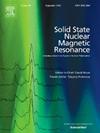Experimental and computational 17O solid-state NMR investigation of Na- and K-(bi)carbonate salts
IF 2.4
3区 化学
Q4 CHEMISTRY, PHYSICAL
引用次数: 0
Abstract
The importance of (bi)carbonate salts cannot be understated. They are vital to the Earth's geology and ecosystems and are used as precursors by chemists for the synthesis of functional materials. Naturally, solid-state NMR (ssNMR) appears as the spectroscopic tool of choice to probe the atomic-level structure and dynamics of (bi)carbonate salts. Of the possible nuclei available as spectroscopic probes in carbonate and bicarbonate ions (i.e., 1H, 13C, and 17O), oxygen-17 is highly attractive. Yet, it is seldom employed, largely due to its low natural abundance (0.04 %) and lack of practical enrichment protocols. Recently, we reported an effective 17O-labeling strategy involving mechanochemistry of Na2CO3·H2O, Na2CO3, NaHCO3, K2CO3·1.5H2O, and KHCO3, and recorded their 17O NMR spectral fingerprints near room temperature. In this work, ultra-low temperature (i.e., 100 K) 17O ssNMR spectra of these phases are acquired at two magnetic fields, 14.1 and 18.8 T, to extract the 17O NMR parameters δiso, CQ, and ηQ for the different oxygen sites, and to further study the influence of dynamics on the spectra. We compare the experimental 17O NMR parameters to those computed with GIPAW-DFT calculations both on static models, and after averaging by molecular dynamics (MD) simulations. This approach was taken to aid in analyzing the structure-spectra relationships and shed light on the dynamics. Lastly, we report the static GIPAW-DFT calculations of 17O NMR parameters for a series of other carbonate salts of interest, further expanding upon current experimental 17O ssNMR results.

Na-和K-(Bi)碳酸盐的实验和计算固态核磁共振研究
(二)碳酸盐的重要性不容低估。它们对地球的地质和生态系统至关重要,被化学家用作合成功能材料的前体。自然,固态核磁共振(ssNMR)成为探测(bi)碳酸盐的原子级结构和动力学的首选光谱工具。在碳酸盐和重碳酸盐离子(即1H, 13C和17O)中可用作光谱探针的可能原子核中,氧-17具有很高的吸引力。然而,它很少被使用,主要是由于其自然丰度低(0.04%)和缺乏实际的富集方案。最近,我们报道了一种有效的17O标记策略,包括Na2CO3·H2O、Na2CO3、NaHCO3、K2CO3·1.5H2O和KHCO3的机械化学,并在室温下记录了它们的17O NMR指纹图谱。本文在14.1和18.8 T两个磁场下获取了这些相的超低温(即100 K) 17O ssNMR谱图,提取了不同氧位的17O NMR参数δiso、CQ和ηQ,并进一步研究了动力学对谱图的影响。我们将实验的17O核磁共振参数与静态模型和分子动力学(MD)模拟平均后的GIPAW-DFT计算结果进行了比较。采用这种方法有助于分析结构-光谱关系和阐明动力学。最后,我们报告了一系列其他感兴趣的碳酸盐盐的17O核磁共振参数的静态GIPAW-DFT计算,进一步扩展了当前的实验17O ssNMR结果。
本文章由计算机程序翻译,如有差异,请以英文原文为准。
求助全文
约1分钟内获得全文
求助全文
来源期刊
CiteScore
5.30
自引率
9.40%
发文量
42
审稿时长
72 days
期刊介绍:
The journal Solid State Nuclear Magnetic Resonance publishes original manuscripts of high scientific quality dealing with all experimental and theoretical aspects of solid state NMR. This includes advances in instrumentation, development of new experimental techniques and methodology, new theoretical insights, new data processing and simulation methods, and original applications of established or novel methods to scientific problems.

 求助内容:
求助内容: 应助结果提醒方式:
应助结果提醒方式:


